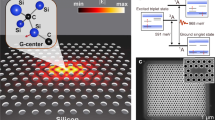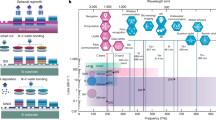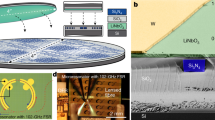Abstract
The application of novel technologies to silicon electronics has been intensively studied with a view to overcoming the physical limitations of Moore’s law, that is, the observation that the number of components on integrated chips tends to double every two years. For example, silicon devices have enormous potential for photonic integrated circuits on chips compatible with complementary metal–oxide–semiconductor devices, with various key elements having been demonstrated in the past decade1,2,3,4,5,6. In particular, a focus on the exploitation of the Raman effect has added active optical functionality to pure silicon7,8,9,10, culminating in the realization of a continuous-wave all-silicon laser11. This achievement is an important step towards silicon photonics, but the desired miniaturization to micrometre dimensions and the reduction of the threshold for laser action to microwatt powers have yet to be achieved: such lasers remain limited to centimetre-sized cavities with thresholds higher than 20 milliwatts12, even with the assistance of reverse-biased p–i–n diodes. Here we demonstrate a continuous-wave Raman silicon laser using a photonic-crystal, high-quality-factor nanocavity without any p–i–n diodes, yielding a device with a cavity size of less than 10 micrometres and an unprecedentedly low lasing threshold of 1 microwatt. Our nanocavity design exploits the principle that the strength of light–matter interactions is proportional to the ratio of quality factor to the cavity volume and allows drastic enhancement of the Raman gain beyond that predicted theoretically13,14. Such a device may make it possible to construct practical silicon lasers and amplifiers for large-scale integration in photonic circuits.
This is a preview of subscription content, access via your institution
Access options
Subscribe to this journal
Receive 51 print issues and online access
$199.00 per year
only $3.90 per issue
Buy this article
- Purchase on Springer Link
- Instant access to full article PDF
Prices may be subject to local taxes which are calculated during checkout




Similar content being viewed by others
References
Liu, A. et al. A high-speed silicon optical modulator based on a metal–oxide–semiconductor capacitor. Nature 427, 615–618 (2004)
Jalali, B. & Fathpour, S. Silicon photonics. J. Lightwave Technol. 24, 4600–4615 (2006)
Barkai, A. et al. Integrated silicon photonics for optical networks. J. Opt. Netw. 6, 25–47 (2007)
Fang, A. W. et al. Hybrid silicon evanescent devices. Mater. Today 10, 28–35 (2007)
Won, R. Integrating silicon photonics. Nature Photon. 4, 498–499 (2010)
Michel, J., Liu, J. & Kimerling, L. C. High-performance Ge-on-Si photodetectors. Nature Photon. 4, 527–534 (2010)
Claps, R., Dimitropoulos, D., Han, Y. & Jalali, B. Observation of Raman emission in silicon waveguides at 1.54 μm. Opt. Express 10, 1305–1313 (2002)
Claps, R., Dimitropoulos, D., Raghunathan, V., Han, Y. & Jalali, B. Observation of stimulated Raman amplification in silicon waveguides. Opt. Express 11, 1731–1739 (2003)
Boyraz, O. & Jalali, B. Demonstration of a silicon Raman laser. Opt. Express 12, 5269–5273 (2004)
Rong, H. et al. An all-silicon Raman laser. Nature 433, 292–294 (2005)
Rong, H. et al. A continuous-wave Raman silicon laser. Nature 433, 725–728 (2005)
Rong, H. et al. Low-threshold continuous-wave Raman silicon laser. Nature Photon. 1, 232–237 (2007)
Yang, X. & Wong, C. W. Design of photonic band gap nanocavities for stimulated Raman amplification and lasing in monolithic silicon. Opt. Express 13, 4723–4730 (2005)
Yang, X. & Wong, C. W. Coupled-mode theory for stimulated Raman scattering in high-Q/V m silicon photonic band gap defect cavity lasers. Opt. Express 15, 4763–4780 (2007)
Loudon, R. The Raman effect in crystals. Adv. Phys. 13, 423–482 (1964)
Ralston, J. M. & Chang, R. K. Spontaneous-Raman-scattering efficiency and stimulated scattering in silicon. Phys. Rev. B 2, 1858–1862 (1970)
Liang, T. K. & Tsang, H. K. Role of free carriers from two-photon absorption in Raman amplification in silicon-on-insulator waveguides. Appl. Phys. Lett. 84, 2745–2747 (2004)
Claps, R., Raghunathan, V., Dimitropoulos, D. & Jalali, B. Influence of nonlinear absorption on Raman amplification in silicon waveguides. Opt. Express 12, 2774–2780 (2004)
Noda, S., Chutinan, A. & Imada, M. Trapping and emission of photons by a single defect in a photonic bandgap structure. Nature 407, 608–610 (2000)
Akahane, Y., Asano, T., Song, B. S. & Noda, S. High-Q photonic nanocavity in a two-dimensional photonic crystal. Nature 425, 944–947 (2003)
Song, B. S., Noda, S., Asano, T. & Akahane, Y. Ultra-high-Q photonic double-heterostructure nanocavity. Nature Mater. 4, 207–210 (2005)
Takahashi, Y. et al. Design and demonstration of high-Q photonic heterostructure nanocavities suitable for integration. Opt. Express 17, 18093–18102 (2009)
Taguchi, Y., Takahashi, Y., Sato, Y., Asano, T. & Noda, S. Statistical studies of photonic heterostructure nanocavities with an average Q factor of three million. Opt. Express 19, 11916–11921 (2011)
Takano, H., Asano, T. & Noda, S. at Spring Meeting Jpn Soc. Appl. Phys., abstr. 29a-ZB-8. (2007)
Terawaki, R., Takahashi, Y., Chihara, M., Inui, Y. & Noda, S. Ultrahigh-Q photonic crystal nanocavities in wide optical telecommunication bands. Opt. Express 20, 22743–22752 (2012)
Song, B. S., Jeon, S. B. & Noda, S. Symmetrically glass-clad photonic crystal nanocavities with ultrahigh quality factors. Opt. Lett. 36, 91–93 (2011)
Han, Z., Checoury, X., Haret, L.-D. & Boucaud, P. High quality factor in a two-dimensional photonic crystal cavity on silicon-on-insulator. Opt. Lett. 36, 1749–1751 (2011)
Baba, T. Slow light in photonic crystals. Nature Photon. 2, 465–473 (2008)
Hagino, H., Takahashi, Y., Tanaka, Y., Asano, T. & Noda, S. Effects of fluctuation in air hole radii and positions on optical characteristics in photonic crystal heterostructure nanocavities. Phys. Rev. B 79, 085112 (2009)
Asano, T., Song, B. S. & Noda, S. Analysis of the experimental Q factors (∼1 million) of photonic crystal nanocavities. Opt. Express 14, 1996–2002 (2006)
Acknowledgements
We especially thank H. Takano for a preliminary calculation done before the start of this project. We thank K. Ishizaki and K. Kitamura for assistance in device fabrication, Y. Tanaka for assistance with finite-difference time-domain calculations, A. Oskooi and H. Ishihara for comments, and Y. Sakamoto for software assistance. Y.T. is supported by the NanoSquare programme, Funds for the Development of Human Resources in Science and Technology, commissioned by MEXT. This work was supported by JST, PRESTO, the NanoSquare programme and MEXT KAKENHI (grant numbers 23104721 and 21104512). The spectral measurements were partly supported by JSPS KAKENHI (grant number 23686015) and the Asahi Grass Foundation. The device fabrication was greatly supported by JSPS KAKENHI (grant number 20226002), the Ministry of Economy, Trade and Industry (METI) through its ‘Future Pioneering Projects’, and the CPHoST programme.
Author information
Authors and Affiliations
Contributions
Y.T. designed the project, designed the original device, fabricated the samples, performed the measurements and wrote the paper. S.N. organized the contribution to the project from Kyoto University, where the fundamental studies to realize high-Q/V nanocavities and the initial investigation into Raman lasers was performed. S.N. also contributed greatly to writing the paper. Y.I. analytically determined the optimum crystalline direction for lasing and contributed to writing Supplementary Information, sections A and B. M.C. established the method to tune the nanocavity mode spacing, T.A. contributed to the theoretical analysis and R.T. contributed to the development of the measurement system.
Corresponding authors
Ethics declarations
Competing interests
The authors declare no competing financial interests.
Supplementary information
Supplementary Information
This file contains Supplementary Text and Data parts A-F, which include a Supplementary Discussion and Equations, Supplementary Figures 1-6 and additional references. (PDF 445 kb)
Rights and permissions
About this article
Cite this article
Takahashi, Y., Inui, Y., Chihara, M. et al. A micrometre-scale Raman silicon laser with a microwatt threshold. Nature 498, 470–474 (2013). https://doi.org/10.1038/nature12237
Received:
Accepted:
Published:
Issue Date:
DOI: https://doi.org/10.1038/nature12237
This article is cited by
-
Broadband high-Q multimode silicon concentric racetrack resonators for widely tunable Raman lasers
Nature Communications (2022)
-
Room-temperature continuous-wave indirect-bandgap transition lasing in an ultra-thin WS2 disk
Nature Photonics (2022)
-
Dual-resonance enhanced quantum light-matter interactions in deterministically coupled quantum-dot-micropillars
Light: Science & Applications (2021)
-
Photonic crystal optical parametric oscillator
Nature Photonics (2021)
-
Global optimization of an encapsulated Si/SiO\(_2\) L3 cavity with a 43 million quality factor
Scientific Reports (2021)
Comments
By submitting a comment you agree to abide by our Terms and Community Guidelines. If you find something abusive or that does not comply with our terms or guidelines please flag it as inappropriate.



